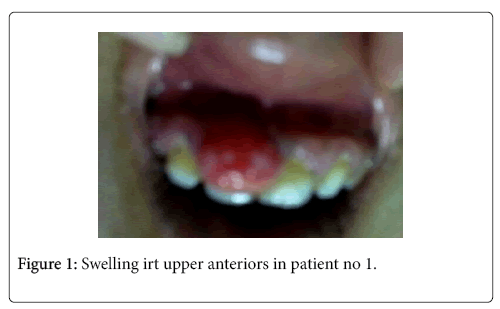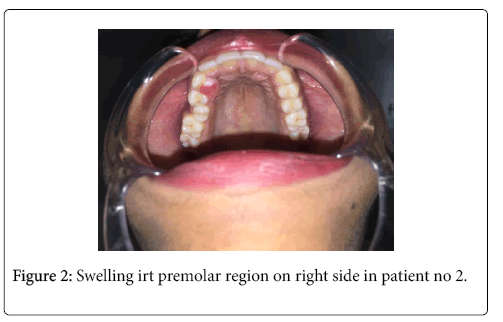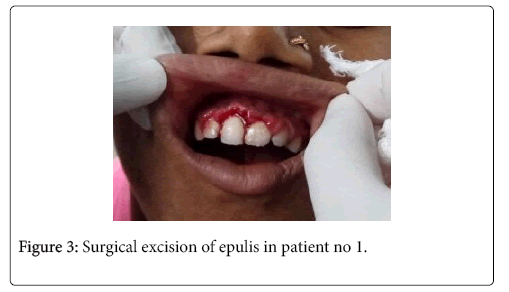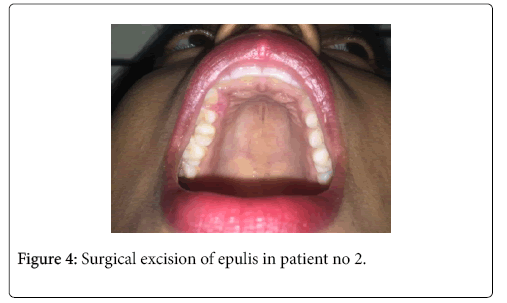Epulis - Commonly Misdiagnosed Entity: A Report of 2 Cases
Received: 19-Mar-2018 / Accepted Date: 04-Apr-2018 / Published Date: 11-Apr-2018 DOI: 10.4172/2376-032X.1000230
Abstract
In the oral cavity, several growths may occur, while some of these growths may be malignant, most of them tend to be benign. Even the benign lesions can be a big problem. Many are locally invasive and inclined to recur and their physical presence in the mouth can lead to traumatic occlusion and entrapment of debris, predisposing to infection. It is therefore of great importance that these growths be treated carefully with the elimination of the causative factors. The aim of this article is to present two such cases where benign pyogenic growths were misdiagnosed as malignant growth causing unnecessary stress and mental trauma to the patient.
Keywords: Epulis; Lesion; Cementicles; Fibroma
Introduction
The epulis is the most frequently encountered benign lesion of the oral cavity [1]. The term epulis was firstly introduced by Virchoff in 1864. The name derives from the ancient Greek word ‘epoulis’ and is an aspecific clinical term that means ‘growth on gums’ [2,3]. It occurs more commonly in females in the ratio of 2:1 [4]. Based on their histopathological findings, epulis has been classified under the following four headings: fibrous, granulomatous (pyogenic granuloma), angiomatous and giant cells epulis [5]. Fibrous epulis usually presents as a firm, pink, uninflamed mass, and it usually tends to grow from below the free gingival margin/interdental papilla. The patient is usually asymptomatic in most cases. Pain may occur secondary to trauma. Histologically, the fibroma may show the additional focus of calcification, foci of cementicles. Angiogranuloma and pyogenic granuloma presents in adults as smooth surfaced mass, often ulcerated and grows from beneath the gingival margin. These epulides are highly vascular, can be compressed on palpation and bleed easily. During the initial period, these epulides tend to grow easily and very rapidly. The mass may penetrate interdentally and present as bilobular (buccal and lingual) mass connected through the col area, but bone erosion in uncommon. When Angiogranuloma appears during pregnancy they are called pregnancy epulis/ tumour or granuloma gravidarum. Peripheral giant cell granuloma occurs particularly in anterior region in young patients or in the posterior mouth during mixed dentition phase and in adults. The purplish-red colour of the epulis is due to high vascularity often causing them to bleed [6].
Its consistency, as well as variable and the colour, depends on the prevalent histologic component ranging from pink to dark red [7]. The etiopathogenesis is not completely clear but seems to be related to several factors in which a key role is played by the reactive inflammatory component that determines its action on cells within the periodontal ligament or the periosteum [8]. Owing to the lack of knowledge about something as minor as epulides, a number of patients and even the treating dentist tends to misdiagnose such cases as cancerous growth thereby affecting the treatment plan and causing unnecessary stress for the patient. The aim of this article is to represent one such case where the patient was under the impression that she had a cancerous growth which was later diagnosed as gingival epulis and finally confirmed by histopathological examination.
Case Presentation
Case 1
A 17 year old female patient reported to the Department of Dentistry, IGIMS, Patna with a chief complaint of swelling of gums over few weeks in duration with slight bleeding on touching. No significant medical and dental history was given by the patient. The growth measured approximately 3×3 in size involving the maxillary 11,12 region. On examination, the swelling was soft and bleeding was noted on light palpation. Patient also gave history that she had visited a number of dentists and physicians for the same and was apprehensive that she was suffering from cancer (Figure 1).
Case 2
A 21 years old female patient reported to the Department of Dentistry, IGIMS, Patna with the chief complaint of swelling in upper front tooth region. The patient did not give any significant medical or dental history. On examination, the swelling was soft and there were no associated symptoms, however, there was bleeding on palpation. The swelling was initially small in size which had increased to its present size (Figure 2).
In both the cases, provisional diagnosis of gingival epulis were given. The gingival growth of the patients was surgically excised after appropriate blood investigations and histopathological examination was conducted (Figures 3 and 4).
Discussion
The homeostasis of the periodontium involves complex multifactorial relationships, in which the endocrine system plays an important role [9]. Hormones are specific regulatory molecules that modulate reproduction, growth and development and the maintenance of internal environments as well as energy production, utilization and storage. Currently accepted periodontal disease classification recognizes the influence of endogenously produced sex hormones on the periodontium. Under the broad category of dental plaque-induced gingival diseases that are modified by systemic factors, those associated with the endocrine system are classified as puberty, menstrual cycle and pregnancy-associated gingivitis. It has been seen that changes in periodontium may occur due to fluctuation in hormonal levels. Women change physically through the production of sex hormones at puberty [10]. This begins with the secretion by the anterior pituitary of gonadotropin hormones (follicle-stimulating hormone and luteinizing hormone), which causes the ovaries to begin cyclical production and secretion of female sex hormones (estrogen and progesterone) [11]. Estradiol is the principal premenopausal estrogen and is produced by the female gonad, the ovary. Estradiol is additionally secreted by the placenta and certain peripheral tissues [12]. Estrogens play a crucial role in many vital activities, including the development and maintenance of secondary sex characteristics, uterine growth, pulsatile release of luteinizing hormone from the anterior pituitary gland and the development of the peripheral and axial skeleton. Another hormone critical for females is progesterone secreted by the corpus luteum, placenta, and the adrenal cortex, and it is active in bone metabolism and has a significant effect in the coupling of bone resorption and bone formation by engaging osteoblast receptors directly [13]. Estrogen and progesterone have significant biological actions that can affect other organ systems including the oral cavity. Receptors for estrogen and progesterone have been demonstrated in the gingiva, in which the gingiva can be thought of as a target organ for progesterone and estrogen [14,15]. Estrogen receptors are also found on periosteal fibroblasts, scattered fibroblasts of the lamina propria, and also periodontal ligament fibroblasts and osteoblasts. Puberty is a phase of transition from maturation into adulthood. Puberty is marked by an elevation in the secretions of the sex steroid hormones: testosterone in males and estradiol in females. Several cross-sectional and longitudinal studies have demonstrated an increase in gingival inflammation without accompanying an increase in plaque levels during puberty. Gingival inflammation has been associated with an increase in levels of estradiol and progesterone without a significant change in the mean plaque index.
A similar finding was noticed in our patients. The age of the patients were 17 and 21, both the patients were undergoing puberty. The cause of the underlying disorder was systemic and hence most of the treating dentists and physicians could not relate the clinical finding to the hormonal imbalance. This lead to the growth being misdiagnosed as a malignant growth and caused undue stress to the patient and their families. The other hormonal conditions which can cause such growth are pregnancy, menopause and postmenopausal phase. However, none of the conditions was present in the patient and hence were ruled out and diagnosis of puberty induced epulis was given. The diagnosis was later confirmed by the histopathological report. After relevant blood investigations were carried out, the epulis was surgically excised and patients were recalled for follow up.
Doctors often tend to misdiagnose these epulides as malignant lesions, such as fibrosarcoma, Burkitt’s lymphoma, or squamous cell carcinoma. In order to be able to make the correct diagnosis, histological examination is crucial. In literature, there is agreement that the treatment of the epulides consists of the complete removal together with the underlying periosteum associated with a thorough curettage of the bone and that the local irritative factors should also be removed. Gingival Disease modified by systemic factors gingivitis associated with diabetes mellitus type I diabetes mellitus is the juvenile onset type affecting young people. Alteration in immune function, impaired glucose uptake by liver, premature apoptosis is abnormalities related to diabetes mellitus. In children with poor metabolic control, gingival inflammation and periodontitis are common. In severe cases, premature tooth loss and impaired immune response to oral flora are seen. Treatment includes disease prevention and control of diabetes.
Conclusion
Epulides are caused by a number of factors thus making it difficult to rule out the exact cause of the growth. Based only on the clinical findings it becomes very difficult to differentiate epulis from closely resembling lesions like peripheral ossifying fibroma and fibroma. Therefore a histopathological confirmation is essential for confirming the diagnosis. Surgical excision of the growth from its base along with the elimination of the causative factor seems to prevent recurrence. In cases where the patients are apprehensive, patient counselling plays an important role and patients needs to be assured about the benign condition of the growth and how the disorder can be treated without any serious complications.
References
- Fonseca GM, Fonseca RM, Cantìn M (2014) Massive fibrous epulis: a case report of a 10-year-old lesion. Int J Dent Oral Sci 6: 182-184.
- Rajanikanth BR, Srinivas M, Suragimath G, Pai BSJ, Walvekar A et al. (2012) Localized gingival enlargement:a diagnostic dilemma. Indian J Dent 3: 44-48.
- Pour MA, Rad M, Mojtahedi A (2008) A survey of soft tissue tumor-like lesions of oral cavity: a clinicopathological study. Iran J Pathol 3: 81-87.
- Laus M, Conti MA, Croce A (2016) Giant fibrous epulis: a case report of a benign mass of the oral cavity. IJOHNS 5: 228-232.
- Agrawal AA (2015) Gingival enlargements: differential diagnosis and review of literature. World J Clin Cases3: 779-788.
- Ajagbe HA, Daramola JO (1978) Fibrouepulis: experience in clinical presentation and treatment of 39 cases. Journal of the National Medical Association 70: 317-319.
- Awange DO, Wakoli KA, Onyango JF, Chindia ML, Dimba EO, et al. (2009) Reactive localized inflammatory hyperplastic of the oral mucosa. East Afr Med J 86: 79-82.
- Mariotti A (1994) Sex steroid hormones and cell dynamics in the Periodontium. OralBiol Med 5: 27-53.
- Guncu GN, Tozum TF, Caglayan F (2005) Effect of endogenous sex hormones on the periodontium- review of literature. Aust Dent J 50:138-45.
- Amar S, Chung KM (1994) Influence of hormonal variation in the periodontium on women. Periodontology 2000 6:79-87.
- Weinstein RL, Kelch RP, Jenner MR, Kaplan SL, Grumbach MM (1974) Secretion of unconjugated androgens and estrogens by the normal and abnormal human testis before and after chorionic gonadotropin. J Clin Invest 53:1-6.
- Gallagher JC, Kable WT, Goldgar D (1991) Effect of progestin therapy on cortical and trabecular bone: comparison with estrogen. Am J Med 90:171-178.
- Vittek J, Munnangi PR, Gordon GG, Rappaport SC, Southren AL (1982) Progesterone “receptors†in human gingiva. IRSC Med Sci 10:381-384.
- Vittek J, Hernandez MR, Wenk EJ, Rappaport SC, Southren AL (1982) Specific estrogen receptors in human gingiva. J Clin Endocrinol Metab 54: 608-612.
Citation: Singh D, Pranab A, Mishra N, Sharma AK, Kumar S, et al. (2018) Epulis - Commonly Misdiagnosed Entity: A Report of 2 Cases. J Interdiscipl Med Dent Sci 6: 230. DOI: 10.4172/2376-032X.1000230
Copyright: © 2018 Singh D, et al. This is an open-access article distributed under the terms of the Creative Commons Attribution License, which permits unrestricted use, distribution, and reproduction in any medium, provided the original author and source are credited.




